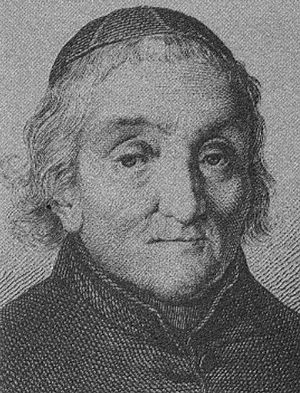Pietro Tamburini facts for kids
Quick facts for kids
Pietro Tamburini
|
|
|---|---|
 |
|
| Born | 1 January 1737 Brescia, Republic of Venice |
| Died | 14 March 1827 Pavia, Kingdom of Lombardy–Venetia |
| Nationality | Italian |
| Occupation | Theologian |
| Employer | |
| Movement | Jansenism |
Pietro Tamburini (born January 1, 1737, died March 14, 1827) was an important Italian thinker. He was a theologian (someone who studies religion) and a jurist (someone who studies law). He taught at a university and openly supported a religious movement called Jansenism.
Contents
About Pietro Tamburini
Pietro Tamburini was born in Brescia, Italy. He received his education from local priests. One of his teachers was Father Scarella, who had ideas similar to Jansenism.
Becoming a Priest and Professor
In 1760, Tamburini became a priest. With the help of the Bishop of Brescia, Giovanni Molin, he became a professor. He taught metaphysics, a type of philosophy, at the Brescia seminary.
In 1771, Tamburini published a book. In this book, he criticized the Jesuits, a religious order. The book was very popular and was printed in many cities across Europe. However, the Bishop of Brescia was pressured by the Jesuits and other local priests. Because of this, Tamburini lost his teaching job in 1772.
Moving to Rome and New Friends
In 1773, Tamburini moved to Rome. With the help of Cardinal Mario Marefoschi, he got a job at the Collegio Irlandese. There, he met other people who shared his Jansenist views. They formed a group called the "Circolo dell'Archetto."
However, the new Pope, Pius VI, was not friendly towards Jansenism. This made things difficult for Tamburini and his friends.
Teaching at the University of Pavia
Later, Empress Maria Theresa of Austria invited Tamburini to teach. He became a professor of moral theology at the University of Pavia. His friend, Giuseppe Zola, also taught there. Tamburini also became the head of studies at the Austro-Hungarian College.
He wrote many books about theology. He also wrote in support of the Austrian government's liberal rule in Lombardy.
Challenges and Later Career
In 1786, Tamburini was invited to a special meeting called the Synod of Pistoia. This meeting aimed to reform the Church with Jansenist ideas. However, many of these ideas were later rejected by Pope Pius VI in 1794.
After Emperor Joseph II died in 1790, the government changed. The new Austrian government was against Tamburini's ideas. In 1794, they removed him from the University of Pavia.
When Napoleon came to power, things changed again. Tamburini was honored with the "Knight of the Order of the Iron Crown." In 1797, he was called back to teach moral philosophy and natural law at the university. This teaching position was sometimes removed and then brought back. Tamburini held it until 1818. He then became the dean of the law faculty.
Notable Works
Pietro Tamburini wrote several important books during his life:
- Idea della Santa Sede (Pavia, 1784): In this book, he discussed the role of the Pope. He believed the Pope was supreme but disagreed with the idea of papal infallibility.
- Introduzione allo studio della filosofia (Milan, 1797): This was an introduction to the study of philosophy.
- Lezioni di filosofia morale, e di naturale e sociale diritto (4 volumes, Pavia, 1806–12): These were lessons on moral philosophy and natural and social law.
- Elementa Juris Naturae (Milan, 1815): This book covered the basics of natural law.
- Cenni sulla perfettibilita dell' umana famiglia (Milan, 1823): This work explored ideas about how human society could improve.
- La Storia generale dell'Inquisizione: A general history of the Inquisition.
See also
 In Spanish: Pietro Tamburini para niños
In Spanish: Pietro Tamburini para niños

